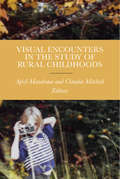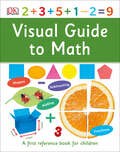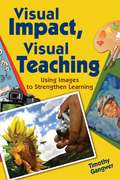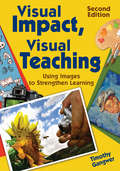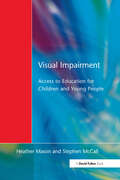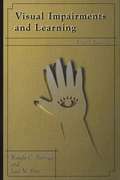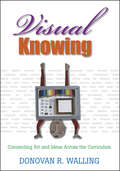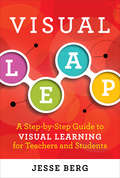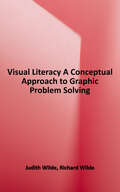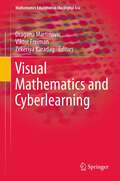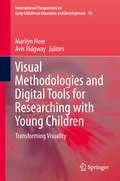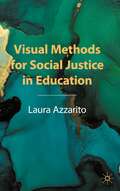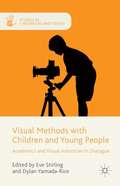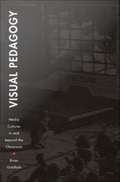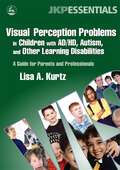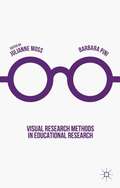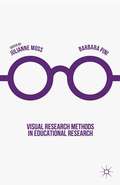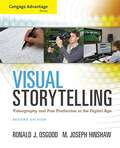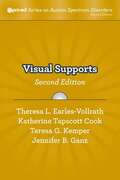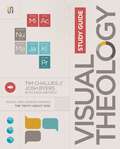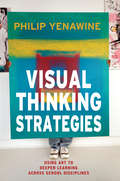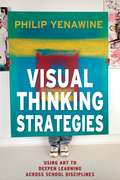- Table View
- List View
Visual Encounters in the Study of Rural Childhoods
by Claudia Mitchell Eric Gottesman Naydene De Lange Relebohile Moletsane April Mandrona Bernard Chan Karren Eppley Wendy Ewald Sally Campbell Galman Diana Carolina Gomez Helle Stranfaard Jensen Renee Jackson Rahul Kamble Irina Kosterina Jonathan Kremser Barbara Turk Niskac Sara Nyhlen Katarina Gritli Nygren Katja Gillander-Gadin Eva Soderberg Kelly Royds Beth Shively Jennifer Vanderburgh Sheilah Wilson Holley WlodarczykVisual Encounters in the Study of Rural Childhoods brings together visual studies and childhood studies to explore images of childhood in the study of rurality and rural life. The volume highlights how the voices of children themselves remain central to investigations of rural childhoods. Contributions look at representations and experiences of rural childhoods from both the Global North and Global South (including U.S., Canada, Haiti, India, Sweden, Slovenia, South Africa, Russia, Timor-Leste, and Colombia) and consider visuals ranging from picture books to cell phone video to television.
Visual Guide to Math (DK First Reference)
by DKKey math vocabulary and concepts for young children explained simply in this friendly and informative reference book.Clear, accessible pictures and diagrams support this first introduction to numbers, calculating, measuring, geometry, and data-collecting, making basic maths skills easier to understand. Packed with key terms and useful tips to help remember as well as practical examples of math in daily life, Visual Guide to Math is ideal even for reluctant kids. Place value, number bonds, multiplication tables, and fractions are just a few of the math concepts explained and reinforced in a variety of ways for children with different learning styles.Covering everything a young child needs to know, this unique reference book follows the curriculum and provides a strong foundation for math skills through the rest of the school years. A perfect homework help to support children as they take their first steps in math and build confidence.
Visual Impact, Visual Teaching: Using Images to Strengthen Learning
by Timothy GangwerEach day, teachers look for new ways to get students excited about learning and new ways to help them retain the information they learn. In this practical guide, Timothy Gangwer incorporates the latest research on visual learning and shows how you can stimulate students' interest and participation. Offering classroom-tested techniques to engage learners' brains, this book includes hundreds of ready-to-use visual learning activities in language arts, math, science, social studies, environmental studies, the arts, and more. This resource covers: Differentiating instruction based on how students process visual information Using graphic organizers, digital photography, the Internet, and other visual communication tools Incorporating music, art, and drama to enhance instruction and learning Teaching visual communication strategies to English language learners Discover how to use visual strategies and activities to help students think critically about the way they understand and perceive the world.
Visual Impact, Visual Teaching: Using Images to Strengthen Learning (2nd Edition)
by Timothy Patrick GangwerOffering classroom-tested techniques to engage learners' brains, this book provides ready-to-use visual learning activities in language arts, math, science, social studies, the arts, and more.
Visual Impairment: Access to Education for Children and Young People
by Juliet Stone Heather Mason Christine Arter Mike McLinden Stephen McCallFirst published in 1998. This book embodies the positive philosophy that children with a visual impairment are entitled to access to the full national curriculum during their school years. In the UK, education placements for pupils and students with special needs range across a continuum from special schools and colleges, with day or residential attendance, to specialist units or individual integration into mainstream provision. Placement results from inter-disciplinary assessment and consultation and requires parental agreement. Lack of sight and measurably impaired vision constitute special needs in educational terms. The writers who have contributed to this major text are teachers and lecturers from both the specialist and mainstream areas of provision and have considerable first-hand experience in teaching pupils and students with a visual impairment.
Visual Impairments and Learning
by Jane N. Erin Natalie C. BarragaNew ways of thinking about individuals with visual impairments are presented and developmental and learning processes are described, for students in education and for regular and special education teachers, clinical and educational vision specialists, parents, and support personnel. Coverage also includes terminology, concerns of the earliest years of life, educational settings, assessment, curriculum, and specialized educational materials. This fourth edition reflects the latest research on how children with visual and additional disabilities learn, offers new ways of looking at curricula for children with visual disabilities, and considers new legislative requirements. Annotation c. Book News, Inc. , Portland, OR (booknews. com)
Visual Knowing: Connecting Art and Ideas Across the Curriculum
by Mr Donovan R. WallingThrough lesson planning ideas, key words, resources, and visual thinking questions, this innovative resource demonstrates how visual arts can be used to teach across all subject areas.
Visual Leap: A Step-by-Step Guide to Visual Learning for Teachers and Students
by Jesse BergVisual Leap is a how-to book for teachers, students and parents interested in making learning easier. In step-by-step fashion, it presents an effective, universal, visual method to teach students how to think independently and critically, and how to organize their ideas for any instructional purpose. The visual strategies are rooted in the science of human learning and are effective because they tap into the ways that we learn naturally. The Visual Leap method simplifies teaching the skills of the Common Core State Standards and gives teachers explicit ways to differentiate instruction to meet the needs of all learners. The strategies work across many grade levels and subject areas and for a wide variety of instructional objectives across the curriculum, such as vocabulary acquisition, reading comprehension, writing, speaking, and listening. Visual Leap offers easy ways to foster dynamic, creative, and critical thinking in the classroom, and provides teachers and students with a toolkit of problem-solving and learning strategies designed to serve them throughout their academic and professional lives.
Visual Literacy: A Conceptual Approach to Graphic Problem Solving
by Richard Wilde Judith WildeNow in a more affordable format for students, this stimulating hands-on course in creative thinking gets right down to specific design problems and offers viable solutions to them. Nineteen challenging assignments and over one thousand pieces of solution art executed by the authors’ students are presented. Each visual problem shows the actual assignment sheet given to the students and includes an analysis of the problem’s underlying intent, addressing principles such as formal reference, negative-positive relationships, cropping techniques, and other important issues.
Visual Mathematics and Cyberlearning
by Viktor Freiman Dragana Martinovic Zekeriya KaradagThis first book in the series will describe the Net Generation as visual learners who thrive when surrounded with new technologies and whose needs can be met with the technological innovations. These new learners seek novel ways of studying, such as collaborating with peers, multitasking, as well as use of multimedia, the Internet, and other Information and Communication Technologies. Here we present mathematics as a contemporary subject that is engaging, exciting and enlightening in new ways. For example, in the distributed environment of cyber space, mathematics learners play games, watch presentations on YouTube, create Java applets of mathematics simulations and exchange thoughts over the Instant Messaging tool. How should mathematics education resonate with these learners and technological novelties that excite them?
Visual Methodologies and Digital Tools for Researching with Young Children
by Marilyn Fleer Avis RidgwayThis book makes an original contribution to researching child-community development so that those with specific interests in early childhood education have new theoretical tools to guide their research practices. The book explicitly theorises the use of digital visual tools from a cultural-historical perspective. It also draws upon a range of post-structuralist concepts for moving research and scholarship forward. Examples of visual technologies from research in different cultural communities are foregrounded. In particular this book introduces contemporary methodologies for researching child and community development with a focus on visual methodology so the dynamics of development can be captured over time and analysed historically, culturally, socially, ecologically and psychologically through a range of iterative techniques. Visual technology was not freely available in Vygotsky's time for example, and therefore potentially represents an extension of his genetic experimental approach to researching child development. The book presents a range of methodological arguments about research into child and community development through which new conceptions for research centred on young children have been created. The authors of the chapters also discuss why a more holistic, dynamic and ethical view of research is needed for generating new knowledge about child development in a range of cultural contexts.
Visual Methods for Social Justice in Education
by Laura AzzaritoThis book makes a case for the usefulness of visual research methods for advancing a social justice agenda in education. The author aims to provide education researchers with a wide range of qualitative visual research tools to invoke different stories, voices, embodiments, and experiences of individuals from marginalized communities; to advance emancipatory research projects; to embrace interdisciplinary knowledge-building; and to counter-narrate Western forms of knowledge, cultures, and values for the reimagining of education for social change. It draws attention to the importance of visual methods in today’s neoliberal landscape of education to speak back to mainstream research and practices, especially when research participants lack words to describe, express, and represent what it means to be impacted by oppression and marginalization.
Visual Methods with Children and Young People: Academics and Visual Industries in Dialogue (Studies in Childhood and Youth)
by Eve Stirling Dylan Yamada-RiceVisual Methods with Children and Young People.
Visual Note-Taking for Educators: A Teacher's Guide to Student Creativity
by Wendi PillarsA step-by-step guide for teachers to the benefits of visual note-taking and how to incorporate it in their classrooms. We've come a long way from teachers admonishing students to put away their drawings and take traditional long-form notes. Let's be honest: note-taking is boring and it isn't always the most effective way to retain information. This book is a guide for teachers about getting your students drawing and sketching to learn visually. Whether in elementary school or high school, neuroscience has shown that visual learning is a very effective way to retain information. The techniques in this book will help you work with your students in novel ways to retain information. Visual note-taking can be used with diverse learners; all ages; and those who have no drawing experience. Teachers are provided with a library of images and concepts to steal, tweak, and use in any way in their classrooms. The book is liberally illustrated with student examples from elementary and high school students alike.
Visual Pedagogy: Media Cultures in and Beyond the Classroom
by Brian GoldfarbIn classrooms, museums, health clinics and beyond, the educational uses of visual media have proliferated over the past fifty years. Film, video, television, and digital media have been integral to the development of new pedagogical theories and practices, globalization processes, and identity and community formation. Yet, Brian Goldfarb argues, the educational roles of visual technologies have not been fully understood or appreciated. He contends that in order to understand the intersections of new media and learning, we need to recognize the sweeping scope of the technologically infused visual pedagogy--both in and outside the classroom. From Samoa to the United States mainland to Africa and Brazil, from museums to city streets, Visual Pedagogy explores the educational applications of visual media in different institutional settings during the past half century. Looking beyond the popular media texts and mainstream classroom technologies that are the objects of most analyses of media and education, Goldfarb encourages readers to see a range of media subcultures as pedagogical tools. The projects he analyzes include media produced by AIDS/HIV advocacy groups and social services agencies for classroom use in the 1990s; documentary and fictional cinemas of West Africa used by the French government and then by those resisting it; museum exhibitions; and TV Anhembi, a municipally sponsored collaboration between the television industry and community-based videographers in São Paolo, Brazil. Combining media studies, pedagogical theory, and art history, and including an appendix of visual media resources and ideas about the most productive ways to utilize visual technologies for educational purposes, Visual Pedagogy will be useful to educators, administrators, and activists.
Visual Perception Problems in Children with AD/HD, Autism, and Other Learning Disabilities: A Guide for Parents and Professionals
by Lisa A. KurtzThis book provides a comprehensive overview of vision problems in children with developmental disabilities such as AD/HD, autism spectrum disorders, and specific learning disabilities. Written in a very accessible style, it is appropriate for parents and professionals alike and offers non-technical explanations of how vision difficulties are screened for and advice on where to seek appropriate professional care. Lisa Kurtz outlines a range of activities for strengthening children's functional vision and perceptual skills using simple, homemade materials that are readily available in the home or classroom. This is an excellent practical companion for parents of children with visual perception problems and the professionals who work with them.
Visual Processes in Reading and Reading Disabilities
by Dale M. Willows Richard S. Kruk Evelyne CorcosOver the last 25 years, reading processes have been the focus of an enormous amount of research in experimental psychology as well as in other disciplines. The theories and models emerging from this research have greatly advanced understanding of both normal acquisition and of reading disabilities. Although great progress has been made, there are certain aspects that have been relatively neglected in the current understanding. Specifically, the role of visual factors has received less attention than that of other component processes. This is particularly surprising since reading and writing are distinct from the other language processes of speaking and listening in large part by virtue of the fact that a visual dimension is involved. Relevant research is broadly scattered both geographically and in terms of disciplines, and there have been no major reviews or books concerned with the visual dimension of reading and reading disabilities. The purpose of this book is to bring together a broad range of evidence that concerns the role of visual information in reading and reading disabilities. Because reading processes are of central interest to cognitive scientists, neuropsychologists, psycholinguists, clinicians, and educators, this book should draw a very broad readership.
Visual Research Methods in Educational Research
by Barbara Pini Julianne MossVisual Research Methods in Educational Research.
Visual Research Methods in Educational Research
by Barbara Pini Julianne MossHave you noticed there is a burgeoning take up of visual research in education? Are you considering using visual research as part of your next research project or revitalising your research methods course? For researchers who are new to the field of VRMs in education there is little critical literature on the subject. This book addresses the gap in the literature and brings together some of the leading educational researchers engaging and reflecting on the visual from Australia, the UK and Canada. Encapsulated in a single volume, this book sets out theoretically grounded discussions of the possibilities and challenges of the approach for educational researchers around four key themes: images of schooling, performing pedagogy, power and representation and ethical issues in educational research.
Visual Storytelling: How To Speak To The Audience Without Saying A Word
by Morgan SandlerVisual Storytelling covers all major components of creating powerful images including lighting, camera functions, composition and storytelling. However, the main focus of the book is not just creating compelling visuals, but more importantly creating images that inform and move the audience. Images carry emotional weight and Visual Storytelling teaches readers how to harness these emotions to maximize the emotion of the story, while minimizing the amount of dialogue necessary. What makes Visual Storytelling unique is that it not only covers the theoretical concepts of filmmaking but also the technical elements necessary to achieve the emotional outcome. This combination of theory and practice helps to create well informed and skilled filmmakers.
Visual Storytelling: Videography and Post Production in the Digital Age
by Ronald J. Osgood M. Joseph HinshawVISUAL STORYTELLING: VIDEOGRAPHY AND POST PRODUCTION IN THE DIGITAL AGE SECOND EDITION combines a thorough exploration of essential storytelling concepts with detailed instruction in practical technical skills. Without limiting its focus to a particular range of equipment, applications, or technology, this engaging text covers the key concepts, aesthetics, and techniques of single-camera field production and post production, and includes real-life stories and suggestions from working professionals.
Visual Supports
by Theresa L. Earles-VollrathVisual supports are essential components of programs serving students with autism spectrum disorders (ASD) and can help provide a variety of information that enables these students to better understand and complete tasks with greater independence. Visual Supports, Second Edition provides information to help educators and families utilize visual displays or cues, such as schedules, boundaries, labels, and consequence maps, to help students with ASD achieve improved learning outcomes. Contents 1. Creating Visual Supports for Students With Autism Spectrum Disorders 2. Visual Supports That Provide Information 3. Visual Strategies That Support Behavior and Emotional Regulation 4. Visual Supports That Structure the Learning Environment 5. Visual Supports That Enhance Cognition and Language Development 6. Visual Supports That Enhance Comprehension of Classroom Instruction 7. Visual Strategies That Support Conversation and Social Skills
Visual Theology Study Guide: Seeing and Understanding the Truth About God
by Tim Challies Josh Byers Zach DietrichWe live in a visual culture. Today, people increasingly rely upon visuals to help them understand new and difficult concepts. The rise and stunning popularity of the Internet infographic has given us a new way in which to convey data, concepts, and ideas.As teachers and lovers of sound theology, Challies and Byers have a deep desire to convey the concepts and principles of systematic theology in a fresh, beautiful, and informative way. In the bestselling Visual Theology, they have made the deepest truths of the Bible accessible in a way that can be seen and understood by a visual generation.As a companion to Visual Theology, the Visual Theology Study Guide is a ten session study designed to help you grow in godliness by practicing what you learn, and it includes application for both personal and small group study. Each chapter includes key terms, group study discussion questions, and exercises for personal reflection in God's Word.X
Visual Thinking Strategies: Using Art to Deepen Learning Across School Disciplines
by Philip Yenawine"What's going on in this picture?" With this one question and a carefully chosen work of art, teachers can start their students down a path toward deeper learning and other skills now encouraged by the Common Core State Standards. The Visual Thinking Strategies (VTS) teaching method has been successfully implemented in schools, districts, and cultural institutions nationwide, including bilingual schools in California, West Orange Public Schools in New Jersey, and the San Francisco Museum of Modern Art. It provides for open-ended yet highly structured discussions of visual art, and significantly increases students' critical thinking, language, and literacy skills along the way. Philip Yenawine, former education director of New York's Museum of Modern Art and cocreator of the VTS curriculum, writes engagingly about his years of experience with elementary school students in the classroom. He reveals how VTS was developed and demonstrates how teachers are using art--as well as poems, primary documents, and other visual artifacts--to increase a variety of skills, including writing, listening, and speaking, across a range of subjects. The book shows how VTS can be easily and effectively integrated into elementary classroom lessons in just ten hours of a school year to create learner-centered environments where students at all levels are involved in rich, absorbing discussions.
Visual Thinking Strategies: Using Art to Deepen Learning Across School Disciplines
by Philip YenawineThe book shows how VTS [Visual Thinking Strategies]can be easily and effectively integrated into elementary classroom lessons in just ten hours of a school year to create learner-centered environments where students at all levels are involved in rich, absorbing discussions.
